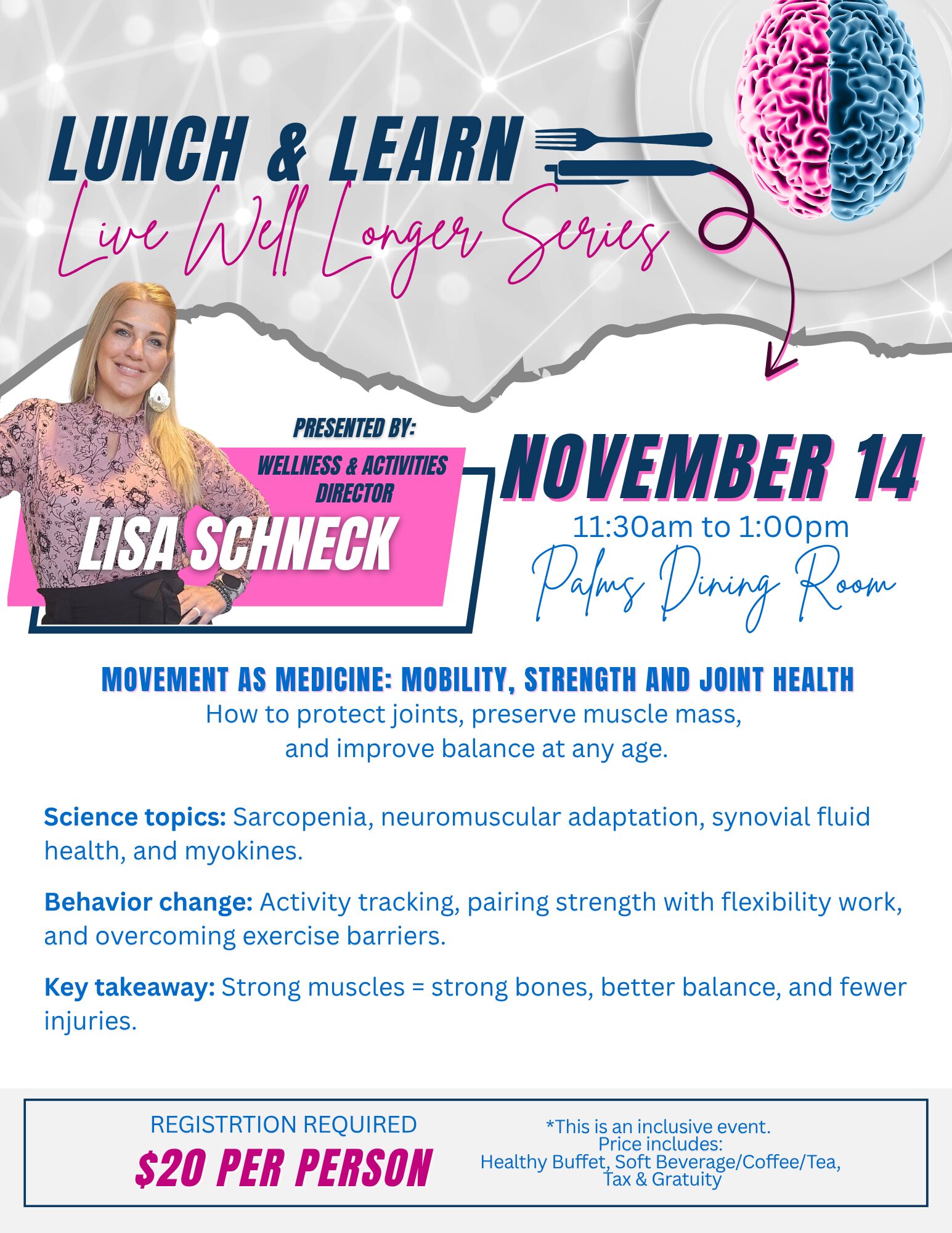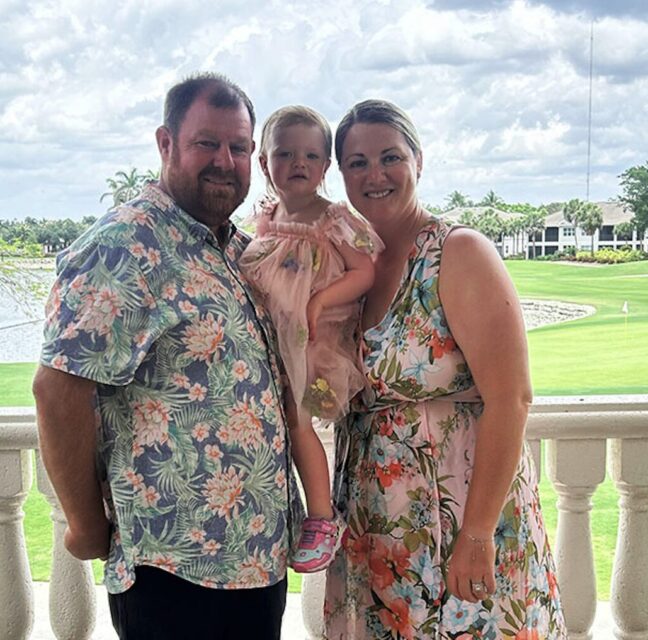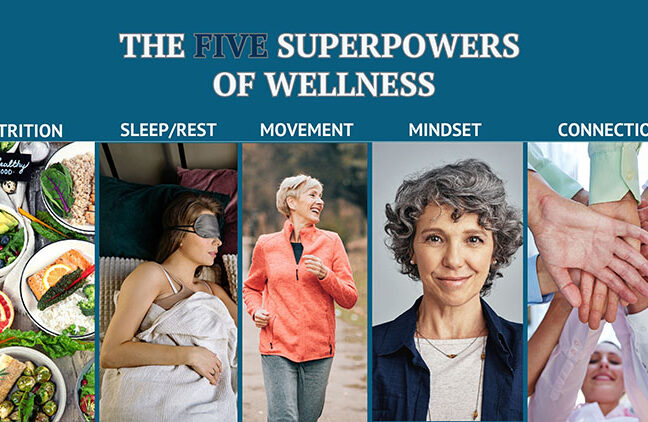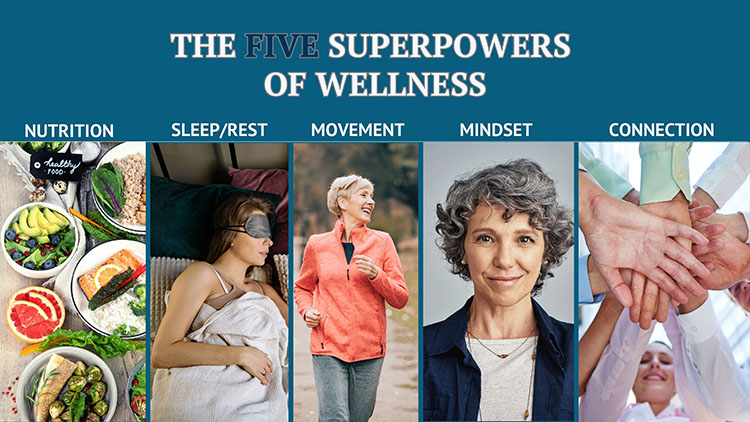
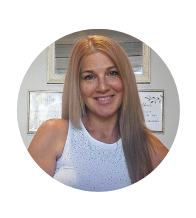
Most people think of aging as an inevitable downhill slide – a gradual loss of energy, function, and independence. But modern science tells a different story. As time passes for all of us, how we age is surprisingly malleable. The biology of aging is influenced by daily choices, and with the right mindset and habits, we can extend not only our lifespan but also our health span – the years we live with vitality and purpose.
This is the essence of the Living Well Longer Lunch and Learn Series: it’s not just about theory, but about practical application. We combine the latest science of aging with proven behavior-change strategies to help you thrive at every stage of life, making the information accessible and applicable to your daily life.
Why We Age: The Hallmarks of Aging
Researchers studying longevity have identified a set of biological processes, often called the “Hallmarks of Aging.” These hallmarks are the wear-and-tear that gradually undermine our body’s resilience. The most important include cellular senescence, mitochondrial decline, and chronic inflammation or “inflammaging.” Each of these hallmarks plays a role in determining how quickly or slowly we age – and importantly, each is influenced by our lifestyle choices.
Cellular Senescence: The “Zombie Cells” Problem
As we age, some of our cells cease to divide. Instead of clearing out, they linger, releasing signals that accelerate tissue damage and inflammation. Scientists refer to these senescent cells as “zombie cells.”
What helps?
• Regular movement (particularly strength training and interval exercise) encourages the body to recycle old cells.
• Nutritional approaches, such as intermittent fasting or polyphenol-rich foods (berries, green tea, dark leafy greens), may help reduce senescent cell buildup.
• Early research into “senolytics” – compounds that target these cells – is underway, but lifestyle remains the best tool for now.
Mitochondrial Health: Powering Your Cells
Mitochondria are the tiny structures inside your cells that convert food and oxygen into energy. With age, mitochondrial efficiency declines, leaving us feeling tired and increasing our susceptibility to disease.
What helps?
• Aerobic exercise is a proven “mitochondrial booster,” stimulating the growth of new, efficient mitochondria.
• Nutrient density matters: foods rich in antioxidants and cofactors like B vitamins, magnesium, and coenzyme Q10 support mitochondrial function.
• Adequate sleep allows mitochondria to repair and regenerate.
• Cutting-edge research suggests that NAD⁺ precursors from diet or supplements may help maintain mitochondrial performance.
Inflammation: When the Body Is Always on Alert
The immune system is designed to fight threats and then stand down. But with age, many people live in a state of chronic low-grade inflammation. This “inflammaging” accelerates diseases like arthritis, heart disease, and dementia.
What helps?
• Anti-inflammatory eating: emphasize whole, unprocessed foods; omega-3s (fatty fish, flaxseed, walnuts); and colorful fruits/vegetables.
• Stress management: mindfulness, breathwork, and social connection lower inflammation markers.
• Consistent sleep: Irregular sleep patterns are directly tied to elevated inflammatory chemicals in the body.
Pulling It All Together: The Interconnected System
The hallmarks of aging are not isolated from one another. Mitochondrial decline can trigger inflammation, and senescent cells can exacerbate mitochondrial dysfunction. This interconnected web is precisely why lifestyle is so powerful: small, consistent changes ripple across multiple hallmarks at once.
Think of it like compound interest for your health – tiny daily deposits that compound over time, growing into decades of improved function.
The Mindset Shift: Aging as a Choice
James Clear, author of Atomic Habits, reminds us that “Every action you take is a vote for the type of person you wish to become.” Applying his principles, we can choose to view aging as an active process of growth:
Identity-Based Habits: Shift from “I want to age well” to “I am the kind of person who invests daily in healthy aging.”
Habit Stacking: Attach small practices to existing routines (e.g., after brushing your teeth, affirm “Today I choose health and energy”).
Environment Design: Surround yourself with cues and people that make healthy, vibrant choices – the easy choices.
By aligning identity, daily actions, and environment, aging becomes less about decline and more about living intentionally with strength and vitality.
Practical Blueprint: How to Begin Today
If you lived to 100, what would you want to be able to do? Travel? Play pickleball? Carry groceries without effort? Whatever your vision, your blueprint starts now. By implementing our Five Wellness Superpowers: nutrition, movement, sleep/rest, connection and mindset.
November 14th Lunch and Learn
The “Living Well Longer” Lunch and Learn series is held monthly, from October to May, in the Palms Dining Room. Our November 14th seminar is titled “Movement as Medicine” and will focus on the importance of mobility, strength, and joint health. Lunch begins at 11:30 a.m. The total cost (including your buffet lunch) is $20 per person. Register today on the Club Calendar!
